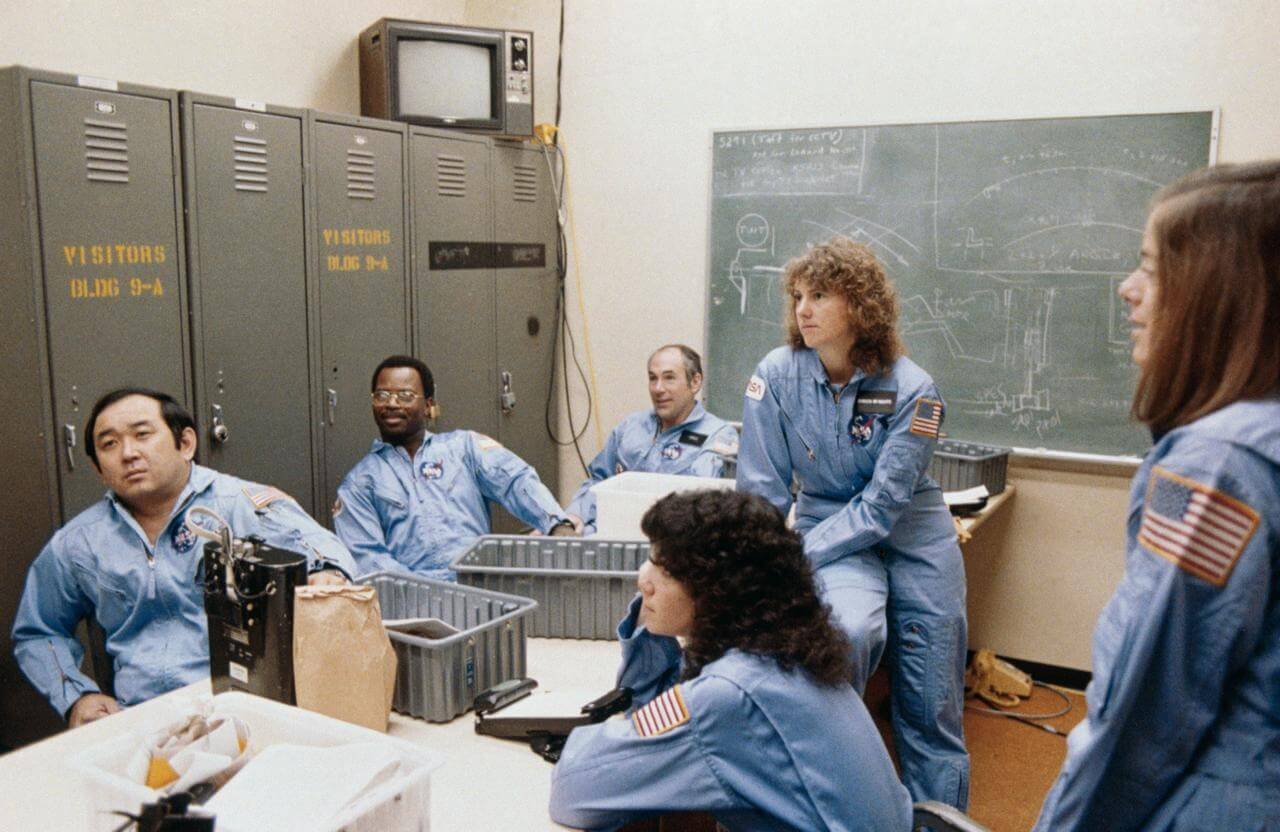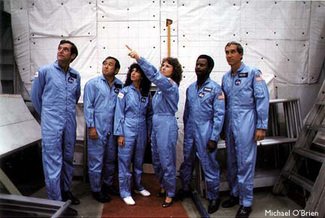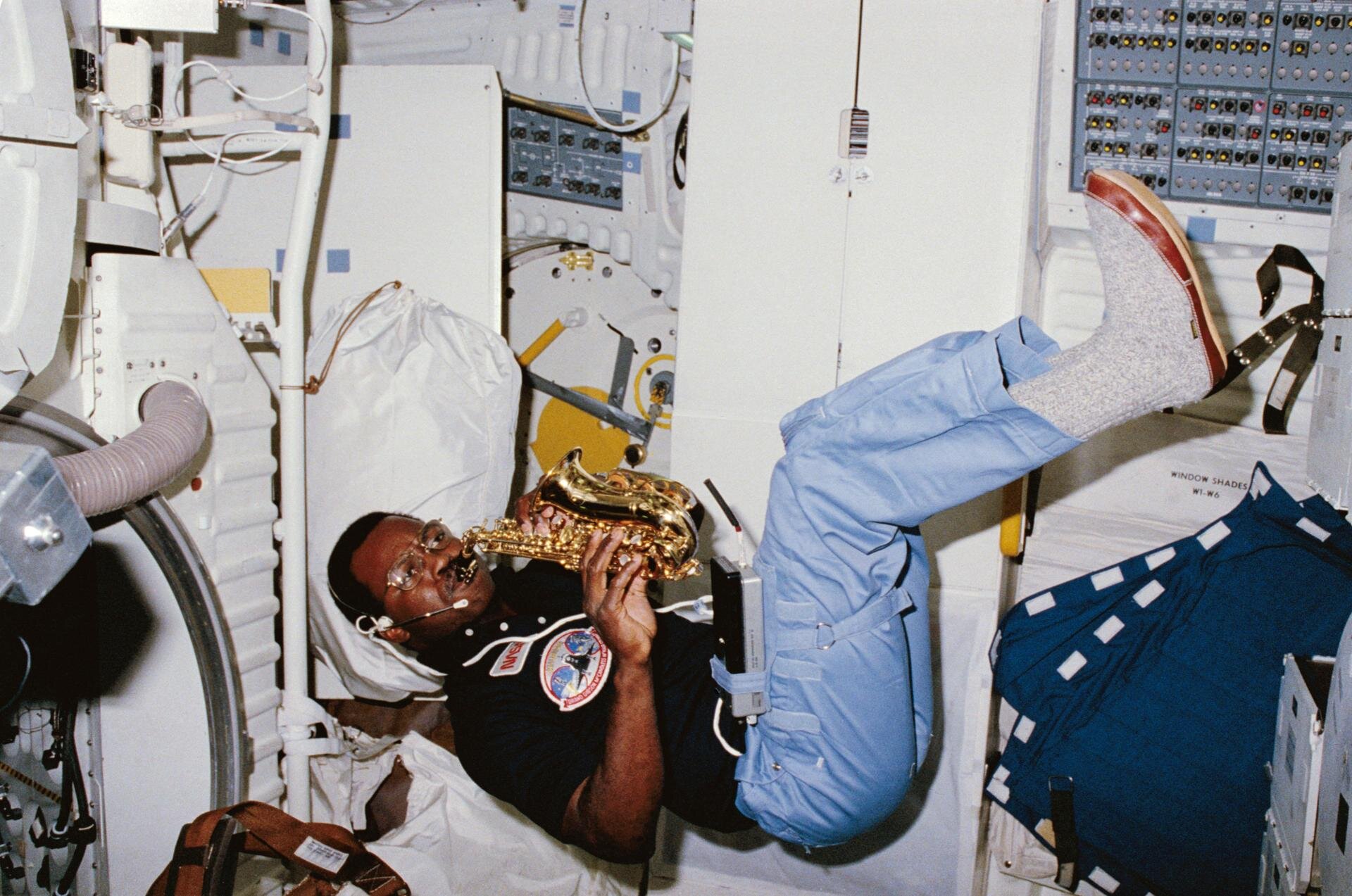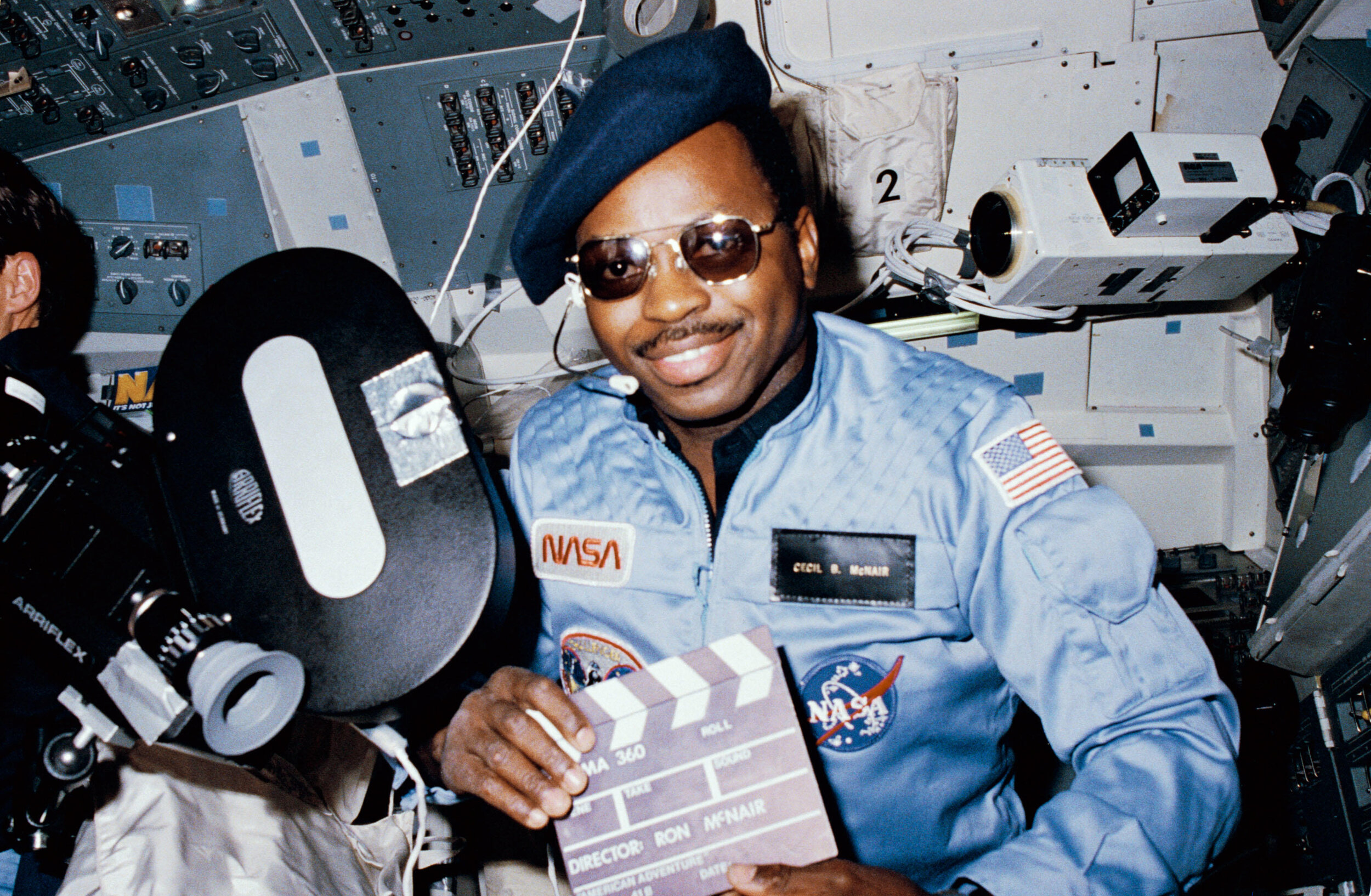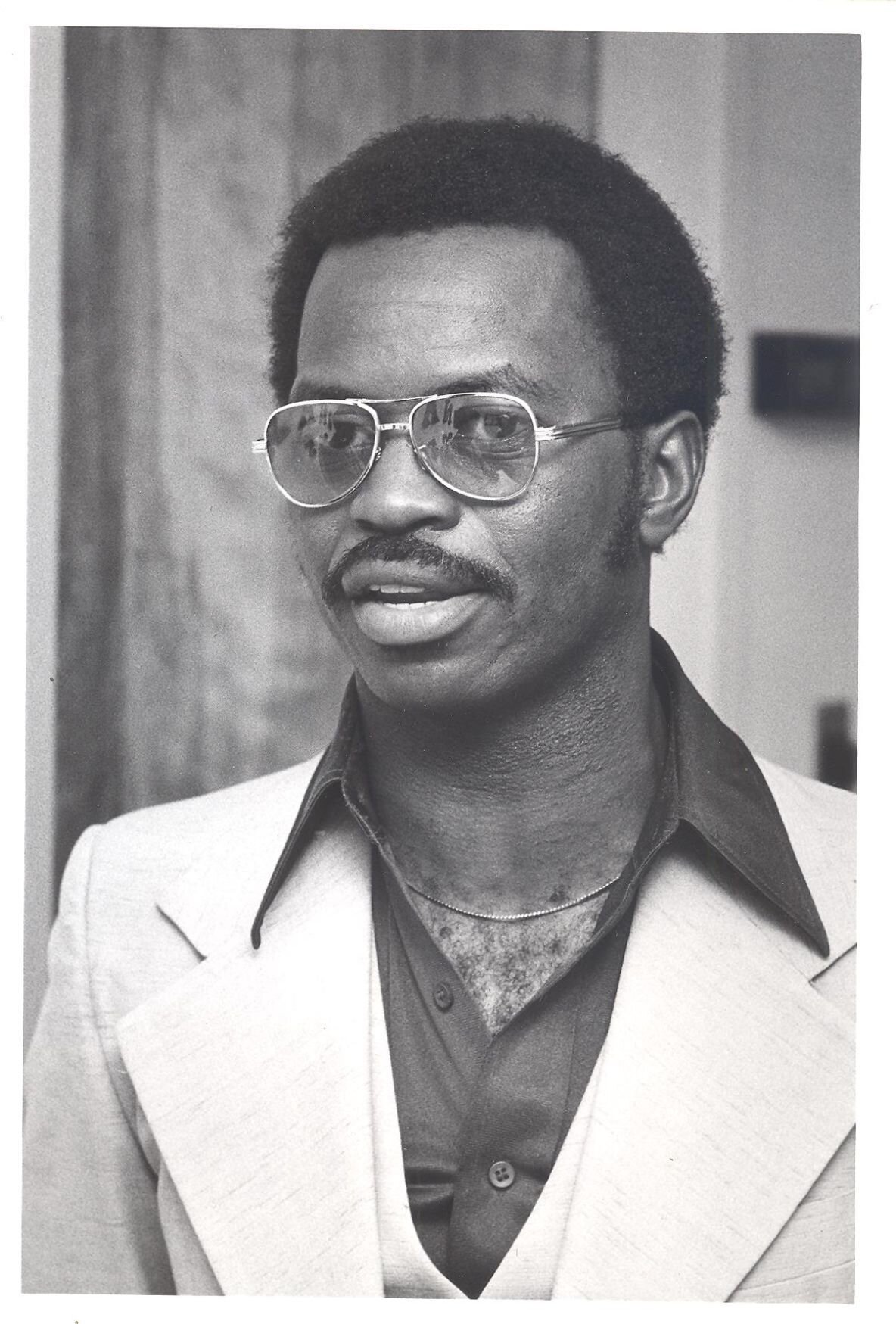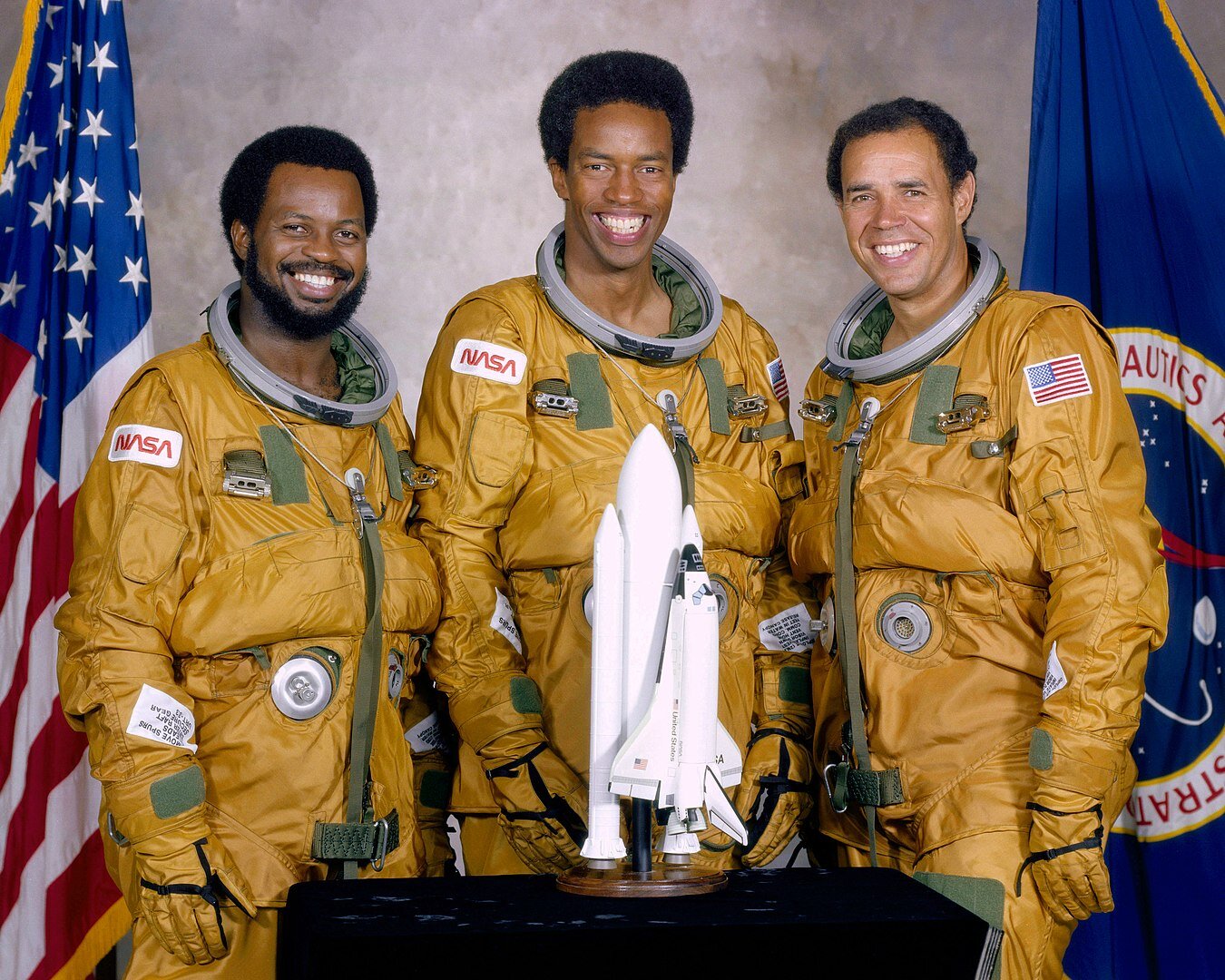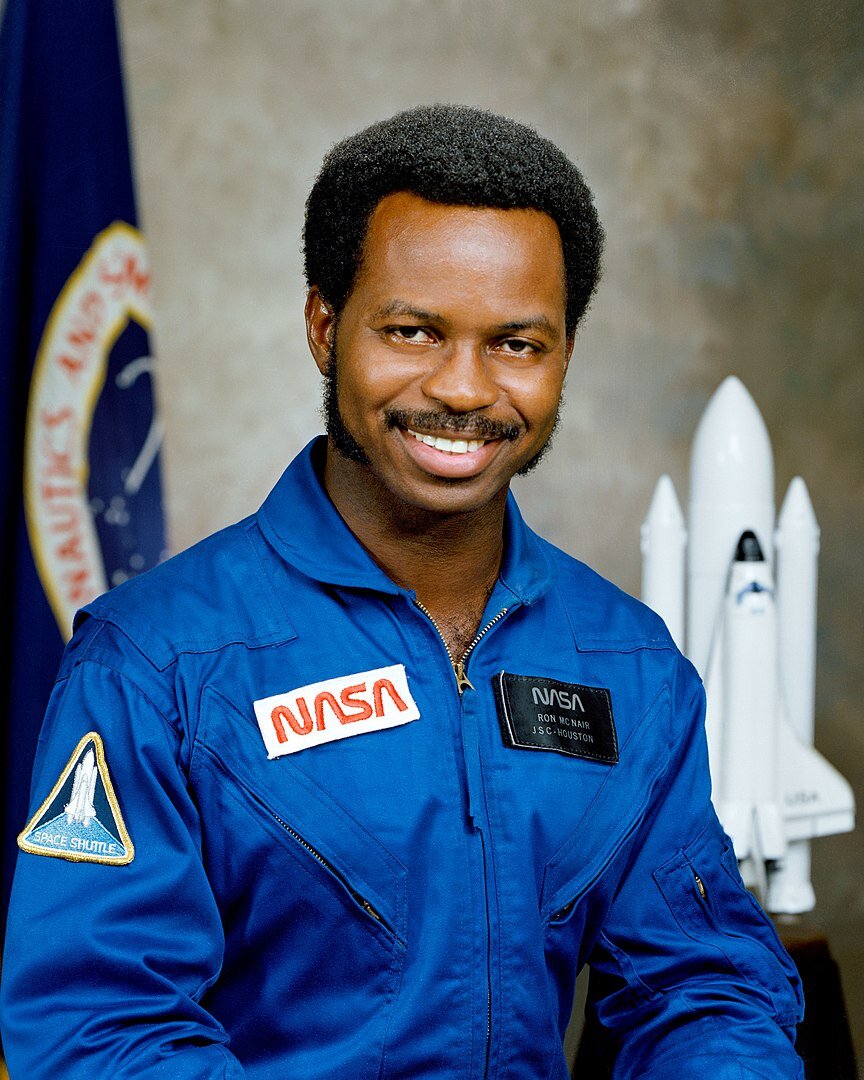Ronald E. McNair
Background
McNair was born October 21, 1950, in Lake City, South Carolina, to Pearl M. and Carl C. McNair. He had two brothers, Carl and Eric A. McNair. In the summer of 1959, he refused to leave the segregated Lake City Public Library without being allowed to check out his books. After the police and his mother were called, McNair was allowed to borrow books from the library; the building that housed the library at the time is now named after him.[2] A children's book, Ron's Big Mission, offers a fictionalized account of this event. McNair's brother, Carl, wrote Ronald's official biography, In the Spirit of Ronald E. McNair—Astronaut: An American Hero.
McNair graduated as valedictorian of Carver High School in 1967.[3]
In 1971, McNair received a Bachelor of Science degree in engineering physics, magna cum laude, from the North Carolina Agricultural and Technical State University in Greensboro, North Carolina.[1] At North Carolina A&T, he studied under professor Donald Edwards, who had established the physics curriculum at the university.[4]
In 1976, McNair received a PhD degree in Physics from the Massachusetts Institute of Technology under the guidance of Michael Feld, becoming nationally recognized for his work in the field of laser physics. That same year, he won the AAU Karate gold medal. McNair would subsequently win five regional championships and earn a fifth degree black belt in karate.[5]
McNair received four honorary doctorates, as well as a score of fellowships and commendations. He became a staff physicist at the Hughes Research Lab in Malibu, California. McNair was also a member of the Omega Psi Phi Fraternity[1] and a member of the Bahá'í Faith.[6][7]
Astronaut career
First three African-American astronauts to go to space, including McNair, Guy Bluford and Fred Gregory from the class of 1978 selection of astronauts.
In 1978, McNair was selected as one of 35 applicants from a pool of 10,000 for the NASA astronaut program. He was one of several astronauts recruited by Nichelle Nichols as part of a NASA effort to increase the number of minority and female astronauts.[8] He flew as a mission specialist on STS-41-B aboard Challenger from February 3 to 11, 1984, becoming the second African American to fly in space.
Challenger disaster
Following the STS-41-B mission, McNair was selected for STS-51-L as one of three mission specialists in a crew of seven. The mission launched on January 28, 1986. He and the other six crew members were killed when Challenger disintegrated nine miles above the Atlantic Ocean, 73 seconds after liftoff.[9]
McNair was initially buried at Rest Lawn Memorial Park in Lake City, South Carolina. His remains were disinterred in 2004 and moved to Ronald E. McNair Memorial Park, located elsewhere in Lake City.[10]
Music in space
McNair was an accomplished saxophonist.
Before his last fateful space mission, McNair worked with French composer and performer Jean-Michel Jarre on a piece of music for Jarre's then-upcoming album Rendez-Vous. It was intended that he would record his saxophone solo on board the Challenger, which would have made McNair's solo the first original piece of music to have been recorded in space[11] (although the song "Jingle Bells" had been played on a harmonica during an earlier Gemini 6 spaceflight). However, the recording was never made, as the flight ended in the disaster and the deaths of its entire crew. The final track on Rendez-Vous, "Last Rendez-Vous," has the subtitle "Ron's Piece," and the liner notes include a dedication from Jarre: "Ron was so excited about the piece that he rehearsed it continuously until the last moment. May the memory of my friend the astronaut and the artist Ron McNair live on through this piece."[12] McNair was supposed to have taken part in Jarre's Rendez-vous Houston concert through a live feed from the orbiting Shuttlecraft.
Public honors
McNair was posthumously awarded the Congressional Space Medal of Honor in 2004, along with all crew members lost in the Challenger and Columbia disasters.
Dr. Ronald E. McNair memorial in his hometown, Lake City, South Carolina
Dr. Ronald E. McNair tomb in his hometown, Lake City, South Carolina
Ronald McNair Park in Brooklyn, New York City
Ronald E. McNair South Central Police Station of the Houston Police Department in Houston, Texas
A variety of public places, people and programs have been renamed in honor of McNair.
The McNair Building (a.k.a. Building 37) at MIT, his alma mater, houses the Kavli Institute for Astrophysics and Space Research.
The McNair Science Center at Francis Marion University in Florence, South Carolina
The McNair Center for Aerospace Innovation and Research at the University of South Carolina is named in his honor.
Ronald McNair Boulevard in Lake City, South Carolina, is named in his honor and lies near other streets named for astronauts who perished in the Challenger crash.
The Quailbrook East development in Somerset, New Jersey has streets named after the Challenger and each of the seven astronauts.[1]
The U.S. Department of Education offers the TRIO Ronald E. McNair Post-Baccalaureate Achievement Program for students with low income, first generation students, and/or underrepresented students in graduate education for doctorate education.
On January 29, 2011, the Lake City, South Carolina, library was dedicated as the Ronald McNair Life History Center.[3] When Ronald McNair was eight, the police and his mother were called because he wished to check out books from this library, which served only white patrons before he arrived. He said, "I'll wait," to the lady and sat on the counter until the police and his mother arrived, and the officer said, "Why don't you just give him the books?" which the lady behind the counter reluctantly did. He said, "Thank you, ma'am," as he got the books.[2] The episode as recalled by his brother Carl McNair has been depicted in a short animated film.[13][14][15]
Several K–12 schools have also been named after McNair.
McNair Memorial Park in El Lago, Texas, is named in his honor.[16]
Ronald E. McNair Middle School in Lake City, South Carolina, was renamed from Carver High School in his honor (he was a high school graduate of the facility).
Dr. Ronald E. McNair Academic High School in Jersey City, New Jersey[17]
Ronald McNair Elementary School in Greensboro, North Carolina
Ronald McNair Elementary School in Germantown, Maryland
Ronald E. McNair Prince Hall Masonic Lodge No. 146 is named in his honor in Suitland, Maryland[18]
Dr. Ronald E. McNair High School in DeKalb County, Georgia, near Decatur
Ronald E. McNair Middle School, San Antonio, Texas – Southwest ISD
Ronald McNair Middle School in DeKalb County, Georgia, near Decatur
Ronald McNair Middle School in College Park, Georgia
The McNair Open Access Computer Lab at California State University, Bakersfield
Ronald McNair Middle School, formerly the Andrew Jackson Intermediate School, in Detroit, Michigan
Ronald E. McNair Administrative Center in University City, Missouri
Ronald E. McNair Elementary School in Hazelwood, Missouri[19]
Ronald Ervin McNair Elementary School in Denton, Texas (Denton ISD)
Ronald McNair Middle School in Rockledge, Florida
Ronald E. McNair Elementary School in Dallas, Texas (Dallas ISD)
Dr. Ronald McNair Junior High School in Pearland, Texas (Alvin Independent School District), is named in honor Dr. McNair.[20]
Ronald E. McNair Junior High School in Huntsville, Alabama[21]
Los Robles Ronald McNair Academy[22] in East Palo Alto, California
PS 5, Dr. Ronald McNair School in Brooklyn, New York City, New York
PS/MS 147 Ronald McNair in Cambria Heights Queens, New York City, New York
McNair Elementary School in Compton, California
Ronald E. McNair Building: Lycée Français de la Nouvelle-Orléans, New Orleans, Louisiana
Ronald E. McNair Building: KIPP Believe College Prep, New Orleans, Louisiana
A building on the Willowridge High School campus in Houston, Texas, is named in honor of McNair.
There is a memorial in the Ronald McNair Park in Brooklyn, New York, in his honor.[23][24][25]
The Dr. Ronald E. McNair Playground in East Harlem, Manhattan, New York City, New York, is named after him.[26]
The Ronald E. McNair Space Theater inside the Davis Planetarium in downtown Jackson, Mississippi, is named in his honor.
The Naval ROTC building on the campus of Southern University and A&M College in Baton Rouge, Louisiana, is named in his honor.
Ronald E. McNair Hall, On the campus of North Carolina A&T State University in Greensboro, North Carolina
The Engineering building at North Carolina A&T State University in Greensboro, North Carolina, is named in his honor. The university holds a McNair Day celebration annually.[27]
McNair was portrayed by Joe Morton in the 1990 TV movie Challenger.
The song "A Drop Of Water", recorded by Japanese jazz artist Keiko Matsui, with vocals by the late Carl Anderson, was written in tribute to McNair.
The Jean Michel Jarre track "Last Rendez-Vous" was re-titled "Ron's Piece" in his honor. McNair was originally due to record the track in space aboard Challenger, and then perform it via a live link up in Jarre's Rendez-vous Houston concert.
The federally-funded McNair Scholars/Achievement Programs award research money and internships to juniors and seniors who are first-generation and low-income, or members of groups that are underrepresented, in preparation for graduate study. 187 institutions participate (as of 2020).[28][29] Michigan State University, Washington State University, and Syracuse University are three examples of these programs and both offer Summer Research Opportunity Program as additional program components.[30]
Personal life
McNair was married to Cheryl McNair, and they had two children.[31] Cheryl is a Founding Director of the Challenger Center, which focuses on space science education.[32]
About Space Shuttle Challenger
Space Shuttle Challenger (OV-099) was a Space Shuttle orbiter manufactured by Rockwell International and operated by NASA. Named after the commanding ship of a nineteenth-century scientific expedition that traveled the world, Challenger was the second Space Shuttle orbiter to fly into space after Columbia, and launched on its maiden flight in April 1983. It was destroyed in January 1986 soon after launch in an accident that killed all seven crewmembers aboard. Initially manufactured as a test article not intended for spaceflight, it was utilized for ground testing of the Space Shuttle orbiter's structural design. However, after NASA found that their original plan to upgrade Enterprise for spaceflight would be more expensive than upgrading Challenger, the orbiter was pressed into operational service in the Space Shuttle program. Lessons learned from the first orbital flights of Columbia led to Challenger's design possessing fewer thermal protection system tiles and a lighter fuselage and wings. This led to it being 1,000 kilograms (2,200 pounds) lighter than Columbia, though still 2,600 kilograms (5,700 pounds) heavier than Discovery.
During its three years of operation, Challenger was flown on ten missions in the Space Shuttle program, spending over 62 days in space and completing almost 1,000 orbits around Earth. Following its maiden flight, Challenger supplanted Columbia as the leader of the Space Shuttle fleet, being the most-flown orbiter during all three years of its operation while Columbia itself was seldom used during the same time frame. Challenger was used for numerous civilian satellite launches, such as the first tracking and data relay satellite, the Palapa B communications satellites, the Long Duration Exposure Facility, and the Earth Radiation Budget Satellite. It was also used as a test bed for the Manned Maneuvering Unit (MMU) and served as the platform to repair the malfunctioning SolarMax telescope. In addition, three consecutive Spacelab missions were conducted with the orbiter in 1985, one of which being the first German crewed spaceflight mission. Passengers carried into orbit by Challenger include the first American female astronaut, the first American female spacewalker, the first African-American astronaut, and the first Canadian astronaut.

